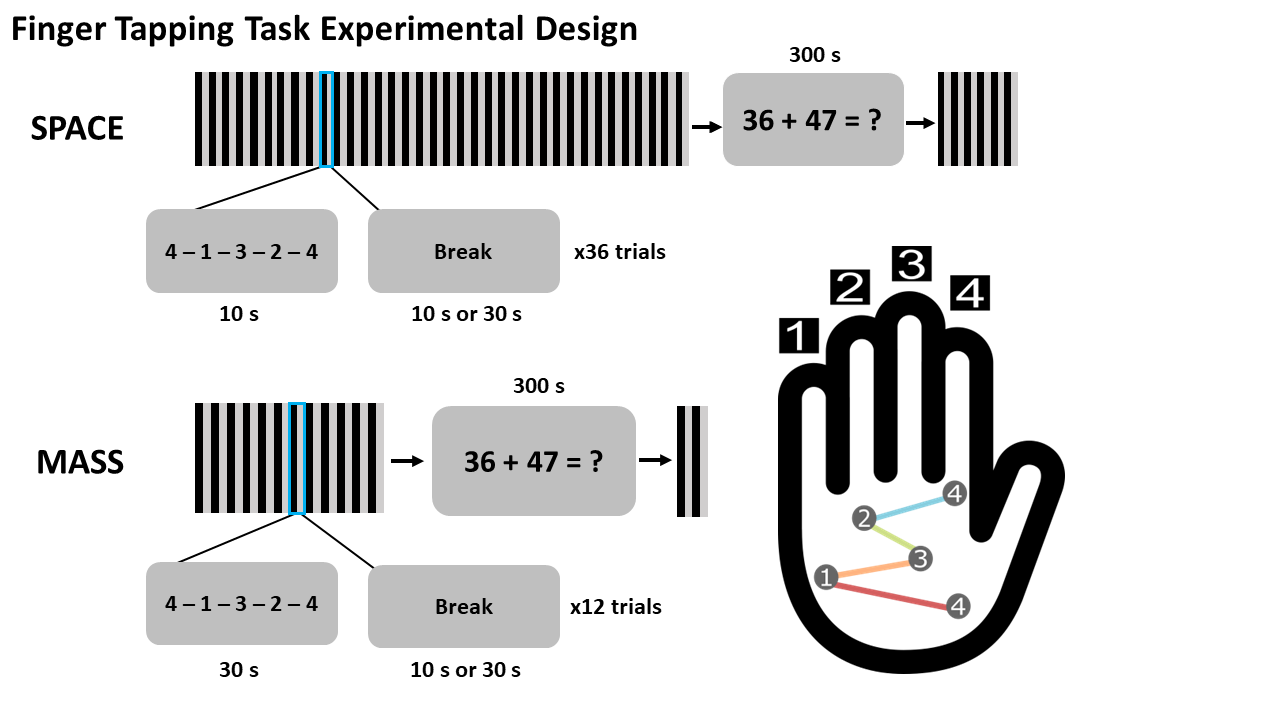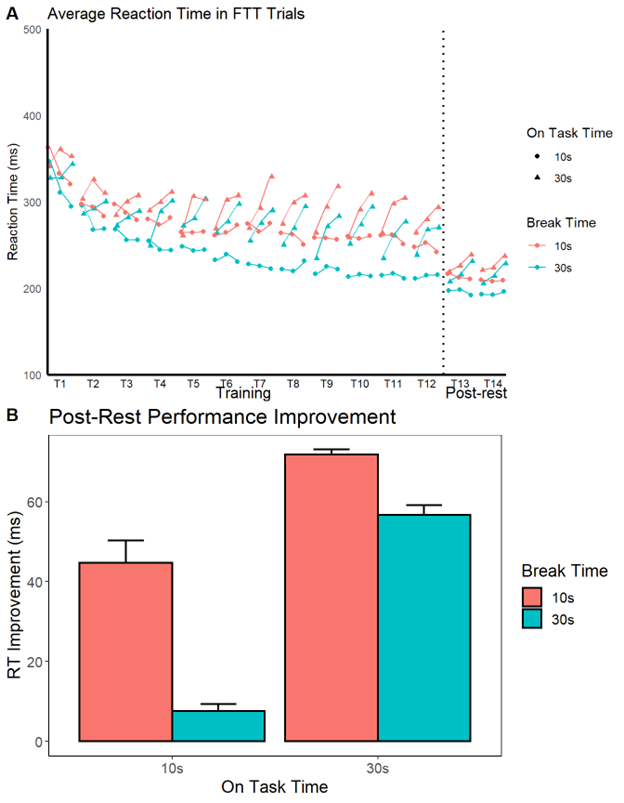When Does Motor Learning Occur?
When does motor learning occur? Intuitively, like declarative learning, one would think that it
would occur concurrently with the task. However, for the past 20 years, researchers have been
proponents that motor learning can occur offline (not concurrently with the task). We’ll call this
the consolidation account. This account has been supported by the repeated finding that there are
performance improvements after rest, whether after sleeping (e.g. 12 hours), 5 minutes, or most
recently, 10 seconds. Some researchers have gone so far to say that “much, if not all” motor
learning occurs offline [1-3]. However, our lab, along with others , have shown that the evidence
for motor learning occurring during sleep is scant [4-8]. In this study, we set out to provide an
alternative account to the claim that learning occurs during a 300 s rest period.
A core factor that has been ignored in studies claiming that learning occurs during offline periods
is reactive inhibition (RI). RI is the worsening of performance as online task time continues. RI
builds up as online task time increases and dissipates during breaks between trials. The more RI
there is, the worse the performance. The current study set out to test both the RI account and the
consolidation account as an explanation for post-rest improvements after 5 minutes.
We did this in a standard finger tapping task where participants repeatedly typed 4-1-3-2-4 for
either 10 s or 30 s trials. Between trials, participants either had 10 s or 30 s breaks (figure 1).
After 360 s of practice, participants had a “break” of 300 s where they performed double digit
addition. After, participants performed the same finger tapping task for 60 s.

Figure 1. Participants repeatedly typed 4-1-3-2-4 over trial. They were randomly assigned to one of
four groups with either 10 or 30 s trial lengths and either 10 or 30 s break lengths.
We replicated past findings of RI during the task (e.g. the worsening of reaction time during the
trial in figure 2a). We found that both on-task trial time and break time significantly affected the
amount of post-rest increase. As predicted by the RI account, the longer the trial and the shorter
the breaks, the greater the post-rest improvement and vice-versa (figure 2b). With a novel
additional assumption to the consolidation account, it too was able to predict a similar pattern of
results. Also of note, we found evidence that RI exists in the 10 s on-task trial, 10 s break group.
This is the same group used in Bönstrup et al., (2020) and Buch et al. (2021), which raises the
possibility that their claims of learning during 10 s breaks may in fact be due to the accrual and
dissipation of RI.
Our findings add to the mounting evidence that challenges a 20 year old idea that motor learning can
occur offline.

Figure 2. A) Each point represents 10 seconds of on-task trial time. In the 30 s on-task trial time
condition, the triangles connected by lines are not separated by breaks. In the 10 s on-task trial
time condition, each circle is separated by a break, even if the line connects them. B) The y-axis
shows the amount of RT improvement after the rest. The x-axis indicates the amount of on-task trial
time, whereas the color indicates the amount of break time. Holding the amount of on-task trial time
constant (x-axis), break time has a strong effect on the amount of RT improvement. When the break
time (color) is held constant, on-task trial time also has a strong effect on RT improvement. Error
bars in standard error.
References
1. Robertson, E. M. (2019). Skill Memory: Mind the Ever-Decreasing Gap for Offline Processing. In
Current Biology (Vol. 29, Issue 8, pp. R287–R289). Cell Press.
https://doi.org/10.1016/j.cub.2019.03.007
2. Bönstrup, M., Iturrate, I., Hebart, M. N., Censor, N. & Cohen, L. G. Mechanisms of offline motor
learning at a microscale of seconds in large-scale crowdsourced data. Npj Sci. Learn. 5, 1–10
(2020).
3. Buch, E. R., Claudino, L., Quentin, R., Bönstrup, M., & Cohen, L. G. Consolidation of human skill
linked to waking hippocampo-neocortical replay. Cell Reports, 35(10) (2021).
https://doi.org/10.1016/j.celrep.2021.109193
4. Rickard, T. C., Cai, D. J., Rieth, C. A., Jones, J. & Ard, M. C. Sleep does not enhance motor
sequence learning. J. Exp. Psychol. Learn Mem. Cogn. 34, 834–842 (2008).
5. Brawn, T. P., Fenn, K. M., Nusbaum, H. C. & Margoliash, D. Consolidating the effects of waking
and
sleep on motor-sequence learning. J. Neurosci. 30, 13977–13982 (2010).
6. Pan, S. C., & Rickard, T. C. Sleep and motor learning: Is there room for consolidation?
Psychological Bulletin, 141(4), 812–834 (2015). https://doi.org/10.1037/bul0000009
7. Nettersheim, A., Hallschmid, M., Born, J., & Diekelmann, S. (2015). The Role of Sleep in Motor
Sequence Consolidation: Stabilization Rather Than Enhancement. Journal of Neuroscience, 35(17),
6696–6702. https://doi.org/10.1523/JNEUROSCI.1236-14.2015
8. Rickard, T. C., Pan, S. C., & Gupta, M. W. Severe publication bias contributes to illusory sleep
consolidation in the motor sequence learning literature. J. Exp. Psychol. Learn Mem. Cogn, (2022).
https://doi.org/10.1037/xlm0001090
Join the mailing list to gain access to our bi-weekly newsletter and software updates!
This site is protected by reCAPTCHA and the Google Privacy Policy and Terms of Service apply.